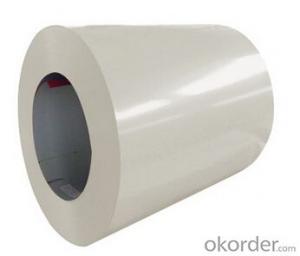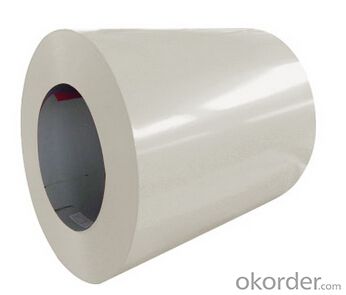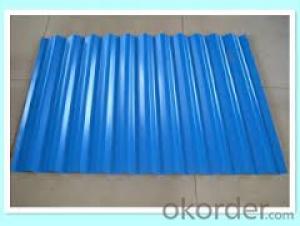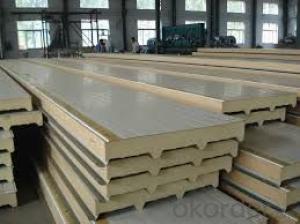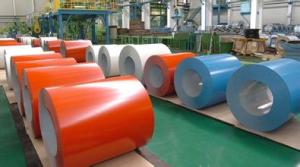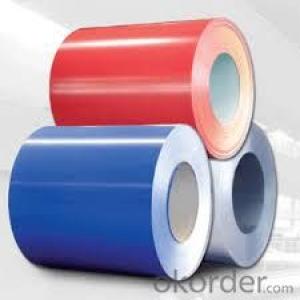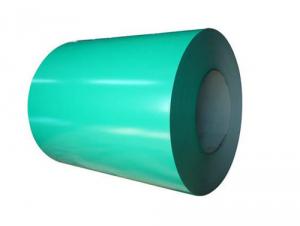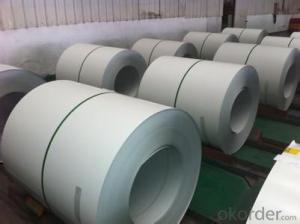Hot DIP Color Coated PPGI Prepainted Steel Coil
- Loading Port:
- Tianjin
- Payment Terms:
- TT OR LC
- Min Order Qty:
- 25 m.t.
- Supply Capability:
- 10000 m.t./month
OKorder Service Pledge
OKorder Financial Service
You Might Also Like
Basic description Info.
Model NO.:SPCC
Surface Treatment:Coated
Certification:ISO, SGS
Technique:Hot Dipped
Standard:ASTM, JIS, GB, AISI, DIN, BS
Application:Roofing Sheet
Edge:Slit edge
Stock:Stock
Steel Grade:Q235
Thickness:0.12mm-1.3mm
Width:600mm-1250mm
Top Paint:15+5
Back Paint:5-7
ID:508mm/610mm
Coil Weight:3-8 Tons
Zinc Coating:50g-250g/Psm
Gloss:65%-80%
Feedback:Within 24 Hours
Film:PE or PVC
Export Markets:Global
Additional Info.
Packing:Export Standard Package or as Request
Standard:AISI, ASTM, BS, DIN, GB, JIS
Origin:China
HS Code:7210701000
Production Capacity:150, 000tons/Year
Product Description
Specification
1.Thickness:0.12mm-1.3mm
2.Width:600mm-1250mm
3.Length:According to client's demands
4.Top paint: 15 to 25 um (5 um + 12-20 um)
Back paint: 7 +/- 2 um
5.Gloss:Normal or High gloss
6.Zinc coating:Z50-Z275G/psm
7.Inside Diameter:508mm/610mm
8.Outside Diameter:1000mm-1500mm
9.Coil weight:3-8 tons
10.Payment:T/T,L/C,D/P,Paypal,Western Union
11.Trade Term:FOB,CFR,CIF
12.MOQ:25 Mt
13.Package:Export standard package or as request
14.Shipment:By container
15.Standard:AISI,ASTM,BS,DIN,GB,JIS
16.Grade:JIS G3322,CGLCC,ASTM A755,CS-B
| Name | Hot Dipped Prepainted Galvanized Steel Coil |
| Resin constructure Technique of production | Double painting and double baking process |
| Productivity | 150,000Tons/year |
| Thickness | 0.12-1.3mm |
| Width | 600-1250mm |
| Coil Weight | 2-7 Tons |
| Inside Diameter | 508mm Or 610mm |
| Outside Diameter | 1000-1500mm |
| Zinc Coating | Z50-Z275G |
| Painting | Top: 15 to 25 um (5 um + 12-20 um) back: 7 +/- 2 um |
| Standard | JIS G3322 CGLCC ASTM A755 CS-B |
| SurfSurface coating coloace coating type | PE, SMP, HDP, PVDF |
| Back side coatingcolor | Light grey, white and so on |
| Application | PPGI is featured with light-weight, good looking and anticorrosion. It can be processed directly, mainly used for construction industry, home electronic apparatus industry, electronic apparatus industry, furniture industry and transportation. |
- Q: I want to buy a chain that will last a long time and that i can wear ALL the time.What are the disadvantages to stainless steel jewelry?Does it look as good as silver?Is there much diference in apperance?
- This Site Might Help You. RE: What Are The Disadvantages Of Stainless Steel Jewelry? I want to buy a chain that will last a long time and that i can wear ALL the time. What are the disadvantages to stainless steel jewelry? Does it look as good as silver? Is there much diference in apperance?
- Q: What are the different types of steel coil handling systems?
- There are several types of steel coil handling systems, including cradle systems, C-hook systems, coil grab systems, and coil transfer cars. These systems are designed to safely and efficiently handle steel coils of various sizes and weights in manufacturing and storage facilities.
- Q: What are the main factors that affect the corrosion resistance of steel coils?
- The main factors that affect the corrosion resistance of steel coils include the composition of the steel, the presence of impurities, the surface finish, the environmental conditions, and the protective coatings applied to the steel.
- Q: I am doing a project on how revolvers work and what materials they use and would like to know what specific grade of stainless steel they use for the manufacturing of the frame and cylinder?
- *Rifle barrels are usually made from steel alloys called ordinance steel, nickel steel, chrome-molybdenum steel, or stainless steel, depending upon the requirements of the cartridge for which they are chambered. The higher the pressure and velocity of a cartridge (pressure and velocity usually go up together), the faster it will wear out a barrel. To give a satisfactory service life, barrels for high velocity cartridges must me made from tougher and harder steel than barrels for lower pressure cartridges. *The 400 (416) series SS commonly known as ordnance grade , is what barrels are made from . *If you want your barrel to be made from super alloy then it is 718 Inconel ,but a costly affair.
- Q: What are the challenges in coil recoiling?
- Coil recoiling, which is also known as coil winding, brings about a range of challenges that depend on the specific application and requirements. Some of the common hurdles encountered in coil recoiling are as follows: 1. Precision and accuracy: Achieving precise and accurate winding is vital for optimal coil performance. It is crucial to maintain consistent tension throughout the winding process, ensure proper alignment, and control the speed in order to prevent variations in the electrical properties of the coil. 2. Wire management: Managing the wire during the recoiling process can be difficult. The wire may be fragile, prone to tangling, or have specific handling requirements, such as being sensitive to magnetic or thermal influences. Employing proper wire management techniques, such as tension control, wire guide systems, and spooling mechanisms, is necessary to prevent wire damage and ensure uniform winding. 3. Space limitations: In many cases, coils need to fit within specific space constraints. Designing and winding coils to fit compact spaces can be challenging, particularly when considering the required number of turns, wire size, insulation, and any additional components or structures that may need to be incorporated. 4. Material selection: The selection of the appropriate wire and insulation material is crucial for optimal coil performance and durability. Factors such as electrical conductivity, thermal properties, mechanical strength, and chemical resistance must be taken into account to ensure that the coil can withstand the operating conditions and environmental factors it will encounter. 5. Heat dissipation: Coils often generate heat during operation, especially in high-power applications. Efficient heat dissipation is crucial to prevent overheating and ensure the longevity of the coil. Techniques such as designing the coil with proper ventilation, utilizing cooling mechanisms, or incorporating heat sinks are employed to address this challenge. 6. Quality control: Ensuring consistent quality in coil recoiling can be challenging due to factors such as variations in wire properties, operator skill, equipment calibration, and environmental conditions. Robust quality control measures, such as conducting regular inspections, performing electrical tests, and monitoring process parameters, need to be implemented to maintain consistent coil performance. In summary, coil recoiling demands meticulous attention, precision, and adherence to specific requirements in order to overcome the challenges and produce high-quality coils that meet the desired performance criteria.
- Q: i know stainless steel swords are decoration, what metal is ok for a sword that is usable
- Why the interest in a 'usable' sword ~~ are you really going to use it?
- Q: How are steel coils used in the production of automotive engine components?
- Steel coils are used in the production of automotive engine components by being processed and shaped into various parts, such as pistons, crankshafts, and connecting rods. The coils are first cut, stamped, and formed into the desired shapes, and then undergo heat treatment and other machining processes to enhance their strength and durability. These components are crucial for the proper functioning of an automotive engine, as they provide structural support and help convert the energy generated by the combustion process into mechanical motion.
- Q: How are steel coils used in the production of electrical switches?
- Steel coils are used in the production of electrical switches as they serve as a crucial component in the electromagnet that enables the switch to function. The magnetic properties of the steel coils allow for the creation of a strong magnetic field when an electric current passes through them, which in turn allows the switch to be activated or deactivated, controlling the flow of electricity.
- Q: What are the common coil packaging methods?
- The common coil packaging methods include shrink wrapping, strapping, banding, and stretch wrapping.
- Q: for my engineering project I have been asked to design a method of suspending a TV of weight 14Kg from a gantry, the TV must be 5m below the gantry. My team have decided to use as a suspension method a steel cylinder of outer diameter of 10cm and an inner diameter of 8, however we now need to work out both the max stress and strain and the actual stress and strain. and help would be useful
- the area of the cylinder bypass area is extensive actual its 28.26 cm^2 so if the wieght is 14 which ability the metallic consists of .5 kg/cm2 , which isn't something we enable metallic the gentle one carry as much as a million.4 t/cm2 that's 1400 kg no longer 0.5 , so dont worry urself approximately deflection....
Send your message to us
Hot DIP Color Coated PPGI Prepainted Steel Coil
- Loading Port:
- Tianjin
- Payment Terms:
- TT OR LC
- Min Order Qty:
- 25 m.t.
- Supply Capability:
- 10000 m.t./month
OKorder Service Pledge
OKorder Financial Service
Similar products
Hot products
Hot Searches
Related keywords
